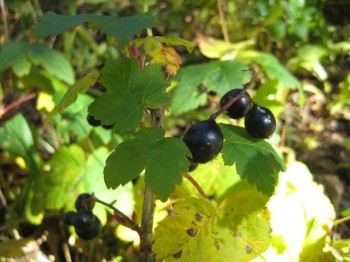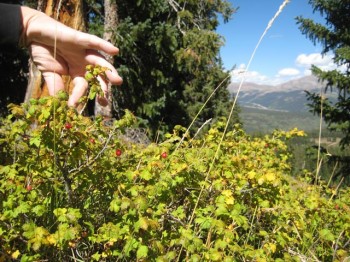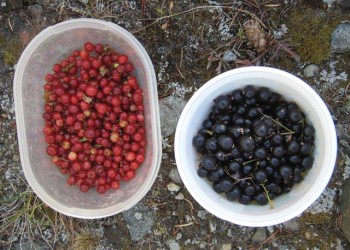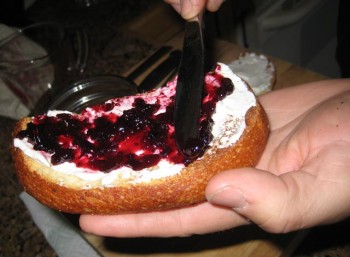
Suddenly, out of nowhere, I absolutely love making jellies and jams!
Mind you, this is a complete about-face from how I felt about them yesterday, especially after Gregg read aloud the brochure that came inside the box of MCP pectin and it said we had to “Measure ingredients exactly” because “ALTERING RECIPES or INGREDIENTS could cause a set failure” (the caps are MCP’s emphasis) while I was failing to get my first-ever jam to set. I felt like Julie Powell about to throw a fit over a Julia Child recipe gone wrong. What do you mean I have to measure the ingredients exactly? I near wailed as one nervous boyfriend tried his best to disappear into the background.

You see, after the better-than-expected soopolallie and jalapeño jelly experiment of the day before, I decided to make a second gelled-fruit concoction with a pint of red and black currants we happened upon a few days ago in a shady valley on the shoulder of Pennsylvania Mountain.
Last year (and this year) we found the small, spiny red hi-bush currants (Ribes spp.), but the big, spine-free, juicy black currants of this year were completely new to us. Gregg spied them first, a few succulent berries low to the ground that we tentatively identified as Ribes based on their tiny hairs and the fact that the leaves were similar to those on the red berry plants, only larger. To top things off, the next day we found what Cattail Bob refers to as gooseberries, the “almost always spiny” wine-colored Ribes inerme var. saxosum, in a lower valley nearby. Yet another unexpected foraging treasure!

To make the jelly, I mashed the small, sticky red currants and the big, plump black currants with a few finely chopped jalapeños and enough water to cover and set them to cook on the stovetop for a few minutes. Next, I strained the juice from the pulp before deciding on jam instead of jelly, for which I ended up food-processing the almost-discarded seeds and skins and adding them back to the pot. Then I dropped in a roughly-estimated amount of pectin and slightly less than ¾ cup of sugar per cup of juice and boiled for 10 minutes like I did with the soapberries—but the darn thing wouldn’t thicken.
That’s when Gregg read the scary pectin instructions aloud to me, making me think I ruined the jam—the one recipe on which I had gambled our entire currant berry bounty.
Somewhere between spilling things and swearing, I decided to abandon the EHow recipe I was following and added lemon juice, more pectin, and a crap-ton more sugar to the boiling berries per the MCP pamphlet. But it was all to no avail. How could it possibly call for that much sugar? I groaned, after realizing that practically every recipe in the pamphlet called for a cup and a half more sugar than crushed berries and juice, or else you risk SET FAILURE. Is jelly really nothing but pure sugar? Argh.
The one comforting bit of information in pamphlet was that jelly that doesn’t set can be re-cooked with pectin again at a later time. So I poured the juice/pulp mixture into two jars and put them out of my sight in the refrigerator.

The next morning, however, to my great surprise, the jam was completely jamified! I could even turn the jar upside down and that currant jam did not budge. And the taste was absolutely amazing to boot. In fact, I would say that red/black currant jalapeno jam is the most delicious jam I have tasted yet to date. Even Gregg, a known jelly-hater, seems to be swaying on the matter.
“I think I might even like jelly, now,” he said, as he applied soapberry jelly to one cracker and currant jam to another, popping them one by one into his mouth.
Jellies and jam. I can’t wait to make them out of everything I find in the woods and then serve them on everything I eat! But more on that later.

I came upon some red berries Wednesday evening. I live in upper Deer Creek Canyon. Email me and I will email you back the photos. Could these be gooseberries or currants?
Mike Sullivan
Hi Mike, I responded to you on Facebook, sorry for the delay. I believe what you have is a hawthorn (Crataegus sp.).
And I thought I was the only one obsessed with jellymaking.
Texas Jelly Maker
http://texasjellymaking.wordpress.com/
I am seven years late, and you must know this already: Although Pomona’s pectin must [or maybe should] be measured, the pectin and calcium can be adjusted for nearly any quantity of jam or jelly. No, I am not a shill for Pomona’s. Yes, it’s organic and as natural as pectin and calcium can be. You already know that calcium is what makes pectin work to hold plant cells together. My description sounds simplistic, but it really is something simple. I am a retired botanist, lived and studied in Colorado, and now live in the Pacific Northwest. I grow many native plants, including currants, so my wife and I make much jam. The golden currants, Ribes aureum, are snatched by the cedar waxwings before we can touch them, but most of the the black currants, R. odoratum, hidden lower on the shrubs, escape the birds.
Hi Ray, Great to hear from you. It’s fun to look back at this old post and how hard it was for me to make jelly back then! I discovered Pomona Pectin too; it’s all I use now… Gosh if you ever come back this way I’d relish a walk and talk with a former Colorado botanist! Cheers, e